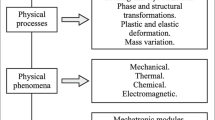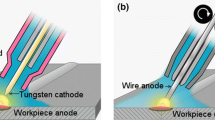Abstract
A three-dimensional computational model of metal–inert-gas welding, which includes the arc, wire and workpiece self-consistently, is presented. It takes into account the phenomena including (1) the motion of the arc relative to the workpiece; (2) the energy, momentum and mass transported by droplets; (3) flow in the weld pool and deformation of its surface; (4) effects of metal vapour and (5) mixing of the wire and workpiece alloys. A graphical user interface has been added. The model predicts the depth and shape of the weld and heat-affected zone and arc and weld pool properties. Thermal histories of the workpiece, required to calculate residual stress and microstructure, are also predicted. Results for welding of aluminium alloy sheets in lap fillet geometry are presented. It is found that the arc temperature is relatively low, due to the high concentration of aluminium vapour, which radiates strongly. The droplets are predicted to mix fairly thoroughly in the weld pool, with the flow in the weld pool driven downwards by the droplet momentum. The orientation of the wire electrode strongly influences the shape and depth of the weld, with a decreased work angle (i.e. further from vertical) leading to a decreased reinforcement height and deeper penetration.









Similar content being viewed by others
References
Murphy AB, Tanaka M, Yamamoto K, Tashiro S, Lowke JJ, Ostrikov K (2010) Modelling of arc welding: the importance of including the arc plasma in the computational domain. Vacuum 85(5):579–584
Tanaka M, Lowke JJ (2007) Predictions of weld pool profiles using plasma physics. J Phys D Appl Phys 40(1):R1–R23
Murphy AB (2010) The effects of metal vapour in arc welding. J Phys D Appl Phys 43(43):434001
Kumar A, DebRoy T (2007) Heat transfer and fluid flow during gas-metal-arc fillet welding for various joint configurations and welding positions. Metall Mater Trans A: Phys Metall Mater Sci 38(3):506–519
Cho MH, Farson DF (2007) Understanding bead hump formation in gas metal arc welding using a numerical simulation. Metall Mater Trans B Process Metall Mater Process Sci 38(2):305–319
Schnick M, Fuessel U, Hertel M, Haessler M, Spille-Kohoff A, Murphy AB (2010) Modelling of gas-metal arc welding taking into account metal vapour. J Phys D Appl Phys 43(43):434008
Gonzalez JJ, Lago F, Freton P, Masquere M, Franceries X (2005) Numerical modelling of an electric arc and its interaction with the anode: part II. The three-dimensional model—influence of external forces on the arc column. J Phys D Appl Phys 38(2):306–318
Hu J, Tsai HL (2007) Heat and mass transfer in gas metal arc welding. Part I: the arc. Int J Heat Mass Transf 50(5–6):833–846
Murphy AB (2011) A self-consistent three-dimensional model of the arc, electrode and weld pool in gas–metal arc welding. J Phys D Appl Phys 44(19):194009
Murphy AB (2013) Influence of droplets in gas–metal arc welding—a new modelling approach, and application to welding of aluminium. Sci Technol Weld Join 18(1):32–37
Murphy AB (2013) Influence of metal vapour on arc temperatures in gas–metal arc welding: convection versus radiation. J Phys D Appl Phys 46(22):224004
Patankar SV (1980) Numerical heat transfer and fluid flow. Hemisphere, Washington DC
van Doormaal JP, Raithby GD (1984) Enhancements of the SIMPLE method for predicting incompressible fluid flows. Numer Heat Transfer 7(2):147–163
Mundra K, DebRoy T, Kelkar KM (1996) Numerical prediction of fluid flow and heat transfer in welding with a moving heat source. Numer Heat Transfer A 29(2):115–129
Voller VR, Brent AD, Prakash C (1989) The modelling of heat, mass and solute transport in solidification systems. Int J Heat Mass Transf 32(9):1719–1731
Kim J-W, Na S-J (1995) A study on the effect of contact tube-to-workpiece distance on weld pool shape in gas metal arc welding. Weld J 74(5):141s–152s
Wu CS, Chen J, Zhang YM (2007) Numerical analysis of both front- and back-side deformation of fully-penetrated GTAW weld pool surfaces. Comput Mater Sci 39(3):635–642
Crowe CT, Sharma MP, Stock DE (1977) The particle-source-in cell (PSI-CELL) model for gas-droplet flows. J Fluid Eng 99(2):325–332
Murphy AB (1993) Diffusion in equilibrium mixtures of ionized gases. Phys Rev E 48(5):3594–3603
Barrett J, Clement C (1992) Kinetic evaporation and condensation rates and their coefficients. J Colloid Interface Sci 150(2):352–364
MatWeb (2012) Aluminum 4043-H18. http://www.matweb.com/search/DataSheet.aspx?MatGUID=2541bb0127b34c7294612c77393ead8c. Accessed 13 June 2012
Punkari A, Weckman DC, Kerr HW (2003) Effects of magnesium content on dual beam Nd:YAG laser welding of Al-Mg alloys. Sci Technol Weld Join 8(4):269–281
Tang Y, Dua Y, Zhang L, Yuan X, Kaptay G (2012) Thermodynamic description of the Al–Mg–Si system using a new formulation for the temperature dependence of the excess Gibbs energy. Thermochim Acta 527(1):131–142
Jácomea PAD, Landima MC, Garciab A, Furtadoa AF, Ferreira IL (2011) The application of computational thermodynamics and a numerical model for the determination of surface tension and Gibbs–Thomson coefficient of aluminum based alloys. Thermochim Acta 523(1–2):142–149
PAD J, Landima MC, Garciab A, Furtadoa AF, Ferreira IL (2011) Corrigendum to “the application of computational thermodynamics and a numerical model for the determination of surface tension and Gibbs–Thomson coefficient of aluminum based alloys” [Thermochim. Acta 523 (2011) 142–149]. Thermochim Acta 526(1–2):262–263
Wang QG, Davidson CJ (2001) Solidification and precipitation behaviour of Al-Si-Mg casting alloys. J Mater Sci 36(3):739–750
Goicoechea J, Garcia-Cordovilla C, Louis E, Pamies A (1992) Surface tension of binary and ternary aluminium alloys of the systems Al-Si-Mg and AI-Zn-Mg. J Mater Sci 27(19):5247–5252
Sklyarchuk V, Plevachuk Y, Yakymovych A, Eckert S, Gerbeth G, Eigenfeld K (2009) Structure sensitive properties of liquid Al-Si alloys. Int J Thermophys 30(4):1400–1410
Assael MJ, Kakosimos K, Banish RM, Brillo J, Egry I, Brooks R, Quested PN, Mills KC, Nagashima A, Sato Y, Wakeham WA (2006) Reference data for the density and viscosity of liquid aluminium and liquid iron. J Phys Chem Ref Data 35(1):285–300
Brandt R, Neuer G (2007) Electrical resistivity and thermal conductivity of pure aluminum and aluminum alloys up to and above the melting temperature. Int J Thermophys 28(5):1429–1446
Ólafsson P, Sandström R, Karlsson Å (1997) Comparison of experimental, calculated and observed values for electrical and thermal conductivity of aluminium alloys. J Mater Sci 32(16):4383–4390
Gaber A, Afify N, Abdel-Latief AY, Mostafa MS (1993) Electrical and microhardness studies on Al-Mg alloys. Sol St Comm 86(19):679–683
Aqra F, Ayyad A (2011) Surface energies of metals in both liquid and solid states. Appl Surf Sci 257(15):6372–6379
Kargl F, Weis H, Unruh T, Meyer A (2012) Self diffusion in liquid aluminium. In: 5th European Conference on Neutron Scattering, Prague, Czech Republic, 2011. Journal of Physics Conference Series. IOP Publishing, p 012077. doi:10.1088/1742-6596/340/1/012077
Murphy AB, Arundell CJ (1994) Transport coefficients of argon, nitrogen, oxygen, argon-nitrogen and argon-oxygen plasmas. Plasma Chem Plasma Process 14:451–490
Cram LE (1985) Statistical evaluation of radiative power losses from thermal plasmas due to spectral lines. J Phys D Appl Phys 18(3):401–411
Essoltani A, Proulx P, Boulos MI, Gleizes A (1994) Volumetric emission of argon plasmas in the presence of vapors of Fe, Si and Al. Plasma Chem Plasma Process 14(4):437–450
Gleizes A, Cressault Y, Teulet P (2010) Mixing rules for thermal plasma properties in mixtures of argon, air and metallic vapours. Plasma Sources Sci Technol 19(5):055013
Murphy AB, Nguyen V, Feng Y, Thomas DG, Gunasegaram D (2017) A desktop computer model of the arc, weld pool and workpiece in metal inert gas welding. Appl Math Model. doi:10.1016/j.apm.2017.01.033
McIntosh C, Mendez PF (2017) Experimental measurements of fall voltages in gas metal arc welding. Weld J 96 (in press)
Murphy AB (2015) A perspective on arc welding research: the importance of the arc, unresolved questions and future directions. Plasma Chem Plasma Process 35(3):471–489
Carlson KD, Lin Z, Beckermann C (2007) Modeling the effect of finite-rate hydrogen diffusion on porosity formation in aluminum alloys. Metall Mater Trans B Process Metall Mater Process Sci 38(8):541–555
Tashiro S, Zeniya T, Yamamoto K, Tanaka M, Nakata K, Murphy AB, Yamamoto E, Yamazaki K, Suzuki K (2010) Numerical analysis of fume formation mechanism in arc welding. J Phys D Appl Phys 43(43):043012
Tashiro S, Murphy AB, Matsui S, Tanaka M (2013) Numerical analysis of the influence of particle charging on the fume formation process in arc welding. J Phys D Appl Phys 46(22):224007
Acknowledgements
The support provided for the work reported here by General Motors, General Motors Holden, and the Commonwealth of Australia, through the AutoCRC, is gratefully acknowledged, as are useful discussions with Drs John Lowke and Eugene Tam of CSIRO, and Dr. Hui-Ping Wang of General Motors.
Author information
Authors and Affiliations
Corresponding author
Additional information
Recommended for publication by Study Group 212 - The Physics of Welding
Rights and permissions
About this article
Cite this article
Murphy, A.B., Thomas, D.G. Prediction of arc, weld pool and weld properties with a desktop computer model of metal–inert-gas welding. Weld World 61, 623–633 (2017). https://doi.org/10.1007/s40194-017-0444-y
Received:
Accepted:
Published:
Issue Date:
DOI: https://doi.org/10.1007/s40194-017-0444-y




